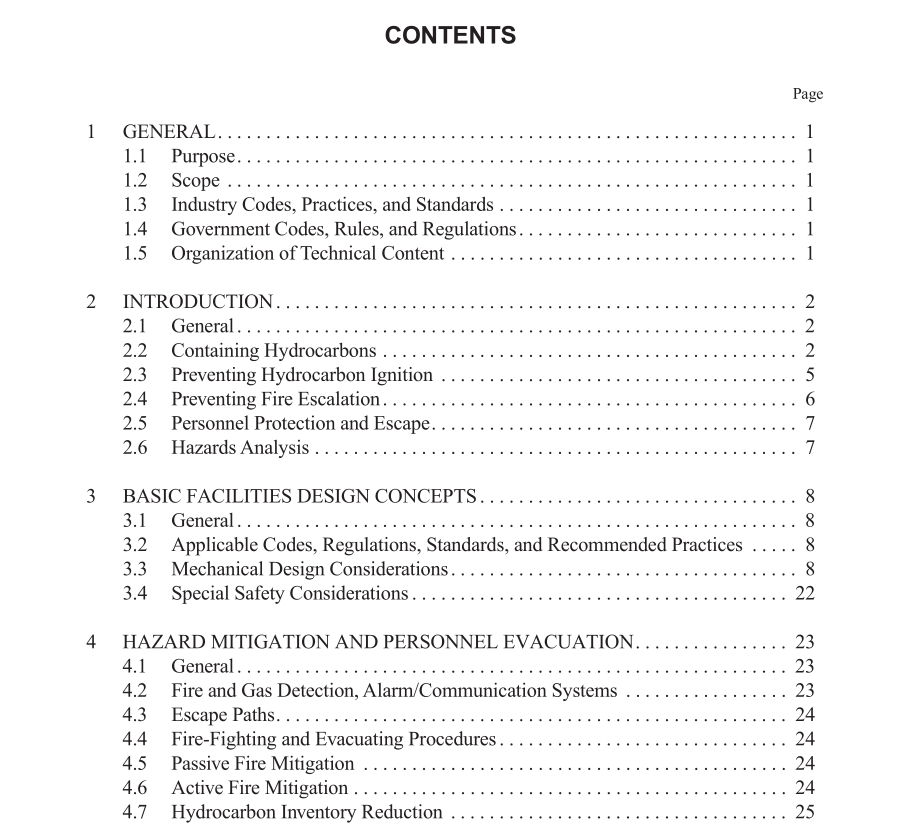API RP 14J pdf download

API RP 14J pdf download.Recommended Practice for Design and Hazards Analysis for Offshore Production Facilities
1 General
1.1 PURPOSE The purpose of this recommended practice is to assemble into one document useful procedures and guidelines for plan- ning, designing and arranging offshore production facilities, and performing a hazards analysis on open-type offshore pro- duction facilities. This will promote safe, pollution free and efficient production of oil and gas. This publication is only a guide and requires the application of sound engineering judg- ment. Furthermore, it is not intended to override or otherwise supersede any existing code or governmental rule or regula- tion, nor is it intended as a comprehensive document contain- ing all useful and appropriate information. 1.2 SCOPE This document recommends minimum requirements and guidelines for the design and layout of production facilities on open-type offshore platforms, and it is intended to bring together in one place a brief description of basic hazards anal- ysis procedures for offshore production facilities. This recom- mended practice discusses several procedures that could be used to perform a hazards analysis, and it presents minimum requirements for process safety information and hazards anal- ysis that can be used for satisfying the requirements of API RP 75. The concepts contained herein recognize that special haz- ard considerations exist for offshore production facilities. As a minimum, these include: 1. Spatial limitations that may cause potential ignition sources being installed in or near production equipment. 2. Spatial limitations that may result in quarters being installed near production equipment, pipeline/flow line risers, fuel storage tanks, or other major fuel sources. 3. The inherent fire hazard presented by the release of flammable liquids or vapors, whether during normal oper- ations or as a result of any unusual or abnormal condition. 4. The severe marine environment, including corrosion, remoteness/isolation, and weather (i.e., wind, wave and current, ice). This recommended practice is directed to those permanent and temporary installations associated with routine produc- tion operations. The guidelines presented herein should pro- vide an acceptable level of safety when used in conjunction with referenced industry codes, practices and standards. 1.3 INDUSTRY CODES, PRACTICES, AND STANDARDS Various organizations have developed numerous codes, practices and standards that have substantial acceptance by industry and governmental bodies. Codes, practices, and stan- dards useful in the design, fabrication, installation, layout, and operation of offshore production facilities are listed in Appendix C. These references are not to be considered a part of this recommended practice except for those specific sec- tions of documents referenced elsewhere in this recom- mended practice. 1.4 GOVERNMENT CODES, RULES, AND REGULATIONS Government regulatory agencies have established certain requirements for the design, fabrication, installation, layout and operation of facilities on offshore production platforms. These requirements may supersede the recommendations of this document. Refer to Appendix D for applicable govern- ment codes, rules and regulations related to the outer conti- nental shelf of the United States.
2 Introduction
2.1 GENERAL The possible consequences of hazardous situations that may occur on all offshore facilities are the same: air and water pollution, fire or explosion, and injury to personnel. Figure 1 is a generic hazard tree that illustrates the interrela- tionship of events, conditions and sources required to lead to these three consequences. If, through good design, it were possible to break each of the chains leading to a hazardous situation, then that hazard could be eliminated. Unfortunately, even the best design can only reduce the probability of a chain occurring and cannot ensure that the chain will always be broken. The goal of a safe facility design is to reduce the risk of each of the identified hazards to a reasonable level. This is done by reducing the probability of occurrence of those events, conditions and sources, and minimizing their conse- quences. It can be seen that the likelihood of occurrence of some of the paths can be minimized by providing sensors to detect measurable changes in process parameters (i.e., pres- sure, level, temperature). However, other chains exist that cannot be broken by sensing process upsets; thus, human intervention, equipment layout and other factors must be addressed in the design.









